45 Small Evergreen Shrubs For Shade (With Pictures) – Identification Guide
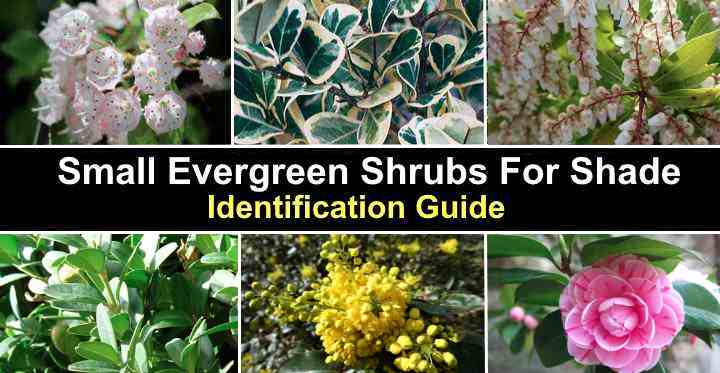
Small evergreen shrubs for shade are perfect for adding year-round color and texture to a shaded garden. Low-growing shade-tolerant shrubs are ideal for filling small spaces and creating a lush, green backdrop for other plants. Evergreen shrubs that thrive in partial or full shade require little maintenance, making them a great choice for busy gardeners.
Whether you’re looking for a shade-tolerant hedge plant for a shady spot in a backyard or a small shrub for the front of your house, there’s an evergreen plant that will thrive in your shaded garden. The most popular small evergreen shrubby plants for shade are wintercreeper, Japanese camellia, boxwoods, and mountain laurel.
This article describes identifying features of the best small evergreen shrubs to grow in shaded areas. Descriptions and pictures of shade-loving dwarf shrubs with evergreen leaves will help you choose the best plants to add greenery and color to your garden landscape. Additionally, you’ll learn about the care and maintenance of these shrubby plants for the shade.
How to Choose Small Evergreen Shrubs for Shade
Selecting the right small shade-tolerant evergreen shrubs for shaded areas is not easy. Some sunlight is necessary for all plants to flourish and blossom. However, some small varieties of shrubs can survive with only an hour or two of sunlight daily. And a few dwarf, evergreen shrubs are suitable for deep shade where they don’t get any direct sunlight.
How Much Sunlight Do Small Shade-Tolerant Evergreen Shrubs Need
To ensure evergreen shrubs grow well in shaded areas, it is essential to determine the amount of sunlight your front or backyard receives. Generally, shade-tolerant shrubs are categorized as partial sun, partial shade, and full (deep) shade. Some shrubs also perform well in dappled shade.
The following are descriptions of the shade levels that shade-tolerant shrubs require:
Full shade or deep shade: Shrubs that thrive in complete shade typically require only a few hours of sunlight from early morning to late afternoon. They also tend to do well in areas with dappled sunlight.
Part shade: To thrive, shrubs for part or light shade require four to six hours of morning sunshine. Typically, they require moderate shade during the hot afternoon sunshine to prevent burning the leaves.
Dappled shade: This type of shade is when sunlight filters through trees or other foliage, creating a patchy pattern of light and shadow.
Types of Small Evergreen Shrubs For Shade (With Pictures) – Identification Guide
Please read on to discover some of the best shade-tolerant evergreen shrubs for shaded garden landscapes.
Small Japanese Camellia (Camellia japonica, Camellia sasanqua)

Evergreen dwarf camellia japonica shrubs are one of the most popular shade-loving landscaping plants
Small Japanese camellias are some of the most popular shade-tolerant evergreen shrubs. The spectacular low growing evergreen shrubs thrive in part or full shade and produce beautiful, showy flowers in shades of pink, red, and white. The eye-catching camellia flowers measure 2” to 4” (5 – 10 cm) in diameter and bloom from spring through fall.
Camellia japonica and camellia sasanqua are popular species of small Japanese camellias that grow well in partial shade or constant shadows.
Camellia japonica: These small evergreen ornamental shrubs grow 6 to 12 ft. (1.8 – 3.6 m) tall, depending on the cultivar. They are characterized by showy flowers and double blooms in shades of pink, red, and white. You can plant these evergreen shrubs as specimen plants, foundation plantings, or flowering hedges. Camellia blooms are also stunning cut flowers, ideal for creating indoor floral arrangements.
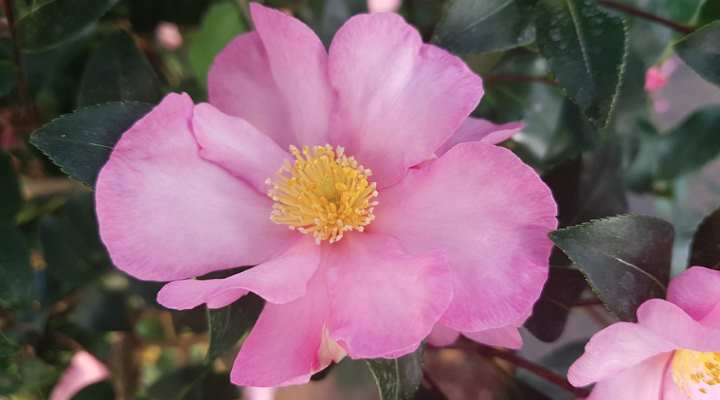
Camellia sasanqua are typically faster growing than camellia japonica with slightly smaller flowers and leaves, and bloom a bit earlier in autumn until late winter
Camellia sasanqua: These low growing evergreen shrubs for shade are fast-growing and produce stunning showy white, pink, or red flowers. These small shrubs thrive in light shade to full shade and can reach up to 10 feet tall (3 m). They have dense green foliage of glossy leaves, perfect for hedges and privacy screens. The blooms of Camellia sasanqua appear in late fall, adding a splash of color to your garden landscape during the winter months.
USDA growing zones: 7 to 9
Sun exposure: Partial sun or full shade
Soil type: Moist, acidic, well-drained soil
Small Evergreen Japanese Skimmia (Skimmia japonica)
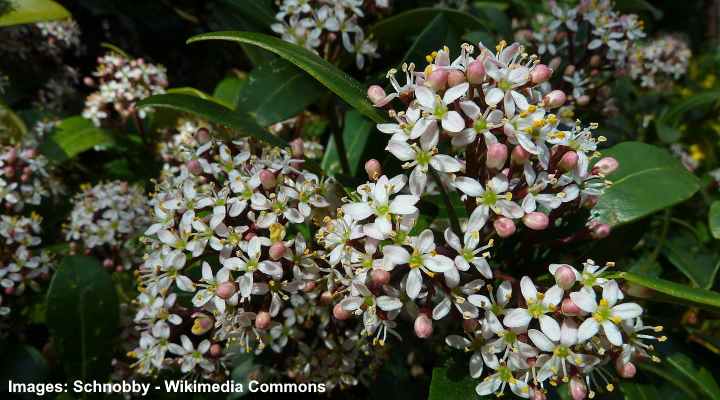
Japanese skimmia is a small flowering evergreen shrub that is easy to care for and loves shade
Small evergreen Japanese skimmia is a low-growing flowering broadleaf evergreen shrub that thrives in partial shade. This ornamental plant produces clusters of fragrant star-shaped white or pink flowers in spring, followed by bright red berries in fall and winter. The glossy, dark green leaves and colorful berries make it an attractive landscaping choice in shaded landscapes.
Small evergreen Japanese skimmia grows 3 to 4 ft. (1 – 1.2 m) tall and 5 ft. (1.5 m) wide. Its compact growth, dome-shaped habit, and attractive features make it an ideal evergreen shrub for small gardens, borders, foundation planting, or hedges. The low-maintenance plant is also deer-resistant.
USDA growing zones: 6 to 8
Sun exposure: Partial shade or full shade
Soil type: Moist, humus-rich, well-drained
Small Japanese Pieris Shrub (Pieris japonica ‘Cavatine’)
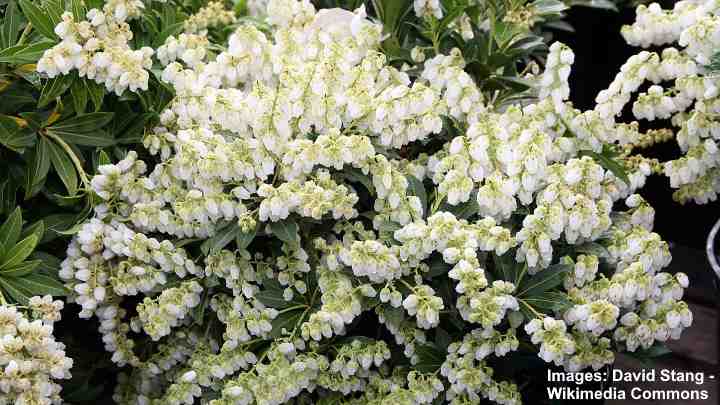
The small flowering Pieris japonica ‘Cavatine’ shrub looks beautiful in any partially shaded front or backyard
The Japanese Pieris shrub ‘Cavatine,’ is a compact evergreen shade-tolerant shrub that doesn’t grow more than 2 feet (0.6 m) in height. Thriving in partial shade, the shrub produces clusters of small, fragrant, white cup-shaped flowers in early spring. These contrast with glossy, dark green leaves.
The Japanese Pieris ‘Cavatine’ cultivar grows 2 ft. (0.6 m) tall and 3 ft. (1 m) wide. Its compact, rounded shape makes it the perfect shrub for landscaping small front or backyards. It’s ideal for foundation plantings, mixed beds, and in front of shrub borders. You can also grow the shrub in containers for patios, decks, and balconies.
USDA growing zones: 5 to 8
Sun exposure: Partial shade
Soil type: Moist, moderately fertile soil
Spotted Laurel (Aucuba japonica)

The spotted laurel is an attractive small shrub for partial sun and shady areas. It’s also an excellent evergreen hedge.
Spotted laurel is an eye-catching low growing evergreen shrub that thrives in partial to full shade. Also known as gold dust plant or variegated laurel, the ornamental feature of the small shrub is its glossy, dark green leaves adorned with yellow spots. The shrub also produces small clusters of shiny red berries in the fall and winter.
Spotted laurel grows 6 to 10 ft. (1.8 – 3 m) tall and 5 to 9 ft. (1.5 – 2.7 m) wide. The shade-loving shrub is an excellent choice for planting along a fence line, an evergreen hedge, foundation planting, or shady shrub borders. Spotted laurel is also a low-maintenance shrub that tolerates various soil types and drought conditions.
USDA growing zones: 6 to 10
Sun exposure: Partial sun to full shade
Soil type: Organically rich, well-drained
Wintercreeper ‘Emerald Gaiety’ (Euonymus fortunei ‘Emerald Gaiety’)
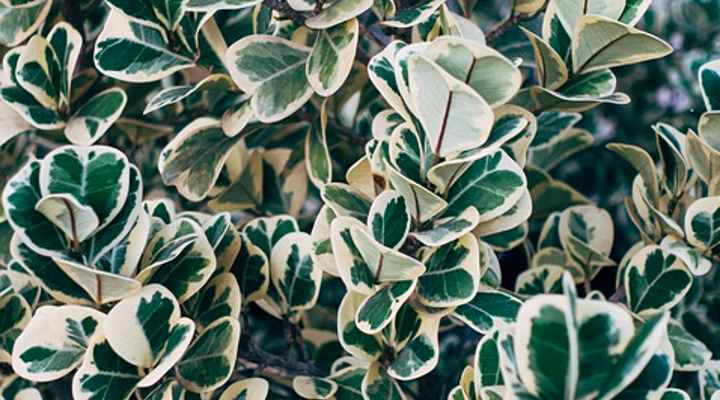
Wintercreeper ‘Emerald Gaiety’ is a shade tolerant small evergreen shrub with variegated white and green leaves
Wintercreeper ‘Emerald Gaiety’ is a versatile small evergreen shrub suitable for partial shade or dappled sunlight. The ornamental features of the small shrub are its glossy green leaves with irregular white edges that turn pinkish in winter. The low-growing shrub grows 4 to 5 ft. (1.2 – 1.5 m) tall.
Wintercreeper ‘Emerald Gaiety’ is ideal for planting as a ground cover, specimen plant, or low hedge. The drought-tolerant shrub is also suitable for growing in containers or hanging baskets. Although its flowers are inconspicuous, the bright variegated leaves add a pop of color to garden landscapes.
Other types of evergreen wintercreeper shrubs that don’t grow more than 2 feet in shaded gardens include the following:
Euonymus fortunei ‘Emerald ‘n’ Gold’: The low-growing evergreen shrub grows 1 to 2 ft. (0.3 – 0.6 m). It features yellow and green variegated leaves.

The colorful foliage of small evergreen Euonymus shrubs adds ornamental element to any garden
Euonymus fortunei ‘Moonshadow’—This small shrub reaches 3 ft. tall (0.9 m) and has brightly colored yellow center and green edged foliage. Grow as a small border shrub wherever you need bold colors in your front or back garden.

Euonymus fortunei ‘Moonshadow’
USDA growing zones: 5 to 9
Sun exposure: Partial shade to full shade
Soil type: Medium moisture, well-drained
Boxwood (Buxus)
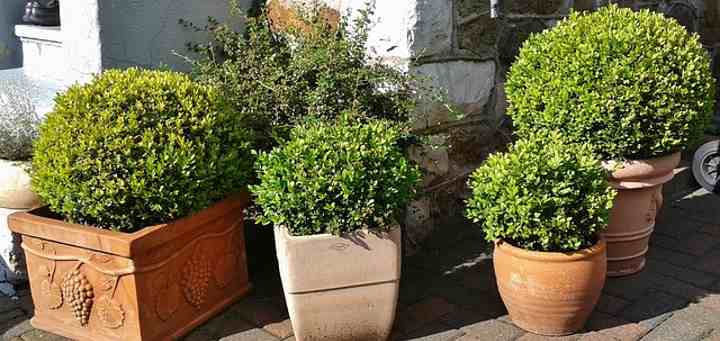
Grow small evergreen boxwood shrubs in the front of house to increase the curb appeal or as a decorative element in sunny or shaded areas
Boxwood is a slow-growing compact evergreen shrub perfect for creating formal hedges in shade gardens. The low-growing dense shrubs feature small, glossy green leaves that stay on the shrub throughout the year. Boxwood shrubs are typically low maintenance, and they respond well to pruning.
Most boxwood shrubs grow between 3 and 5 ft. (1 – 1.5 m) tall and 2 to 3 ft. (0.6 – 1 m) wide. The shrubby plants are ideal for creating borders, defining garden spaces, or adding structure to a landscape design. Once established, the landscaping shrubs are drought-tolerant.
USDA growing zones: 5 to 9, depending on the variety
Sun exposure: Full sun, partial shade, or heavy shade
Soil type: Evenly moist, well-drained soils
Oregon Grape Holly (Mahonia aquifolium or Berberis aquifolium)
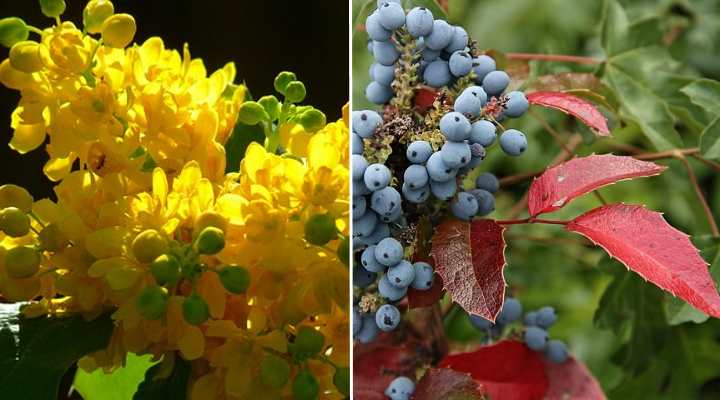
Oregon grape holly is a flowering evergreen shrub with yellow flowers in early spring, followed by blue berries, and is small enough for accenting front of house shaded areas
Creeping mahonia is a low-growing evergreen shrub known for its glossy, holly-like leaves, vibrant yellow flowers, and bunches of blue-black berries. The low-growing suckering shrub blooms in spring when its clusters of bright flowers contrast with the green, spiny leaves. Its edible bluish berries persist through late summer, attracting birds.
Also called Oregon grape holly, this small shrub grows 3 to 6 ft. (0.9 – 1.8 m) tall and spreads up to 5 ft. (1.5 m) wide. Its tolerance for heavy shade makes it ideal for underplanting taller trees and shrubs. You can also plant creeping mahonia in shady borders or along a foundation line for year-long lush color.
- USDA growing zones: 5 to 8
- Sun exposure: Full shade to partial shade
- Soil type: Well-drained, organically rich, acidic, moist soils
Small Eastern Hemlock Shrub (Tsuga canadensis ‘Jeddeloh’)
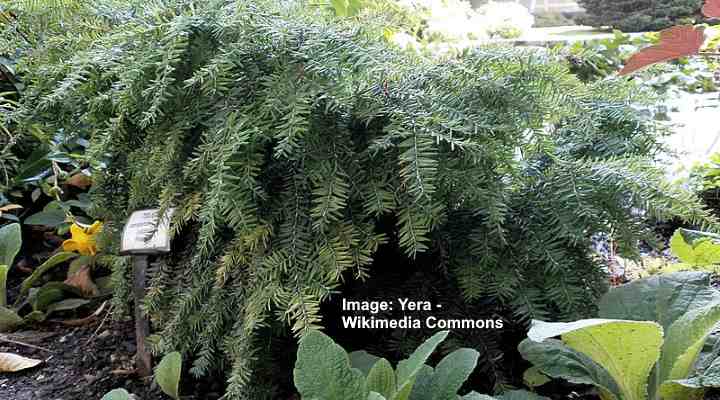
The cultivar ‘Jeddeloh’ is a small eastern hemlock evergreen shrub suitable for partial or full shade
The small Eastern hemlock shrub cultivar ‘Jeddeloh’ is a compact evergreen shrub that grows 2 feet (0.6 m) tall. This evergreen plant is characterized by its small, bright green needles and graceful, arching branches. It also has a flat-topped, spreading habit that resembles a bird’s nest. The slow-growing evergreen shrub takes ten years to grow 2 feet.
The ‘Jeddeloh’ eastern hemlock is perfect for small gardens without direct sunlight. You can plant it as an evergreen ground cover in the shade, foundation planting, or understory shrub. It also requires little maintenance, making it an ideal plant for busy gardeners.
USDA growing zones: 4 to 7
Sun exposure: Partial shade, full shade
Soil type: Medium moist, acidic, humus-rich soils
Evergreen Compact Japanese Holly (Ilex crenata ‘Compacta’)

Evergreen compact Japanese holly is a small and slow growing shrub for sunny or partially shaded areas
The Japanese holly ‘Compacta’ is a small, slow-growing shrub that thrives in full sun or partial shade. The shrub is known for its lustrous, dark green leaves, clusters of fragrant white flowers, and small black berries in late summer and fall. The glossy leaves grow to 1” (2.5 cm) long and form a rounded, spreading shape.
The ‘Compacta’ Japanese holly cultivar is a low-maintenance shrub that requires occasional pruning to maintain its shape. The evergreen shrub grows 6 to 8 ft. (1.8 – 2.4 m) tall and up to 10 ft. (3 m) wide. Its lush evergreen foliage and an attractive shape make it an ideal plant for partially shaded gardens as a foundation planting, border plant, or evergreen hedge.
USDA growing zones: 6 to 8
Sun exposure: Full sun or partial shade
Soil type: Tolerant of poor, sandy soil but thrives in clay soil
Small Pittosporum Evergreen Shrubs

The small evergreen Golf Ball pittosporum (Pittosporum tenuifolium ‘Golf Ball’) can tolerate partial shade
Small pittosporum evergreen shrubs are ideal for shade planting in compact spaces. These low maintenance evergreen shrubs feature glossy, dark green leaves, some of which have green, yellow or white variegation. Small, dark purple flower clusters appear in late spring and emit a sweet honey-like fragrance.
Pittosporum shrubs are perfect for planting as a foundation plant, border shrub, or specimen plant. Its tolerance to salt air means it’s also ideal for coastal gardens. The low-growing shrubs grow 6 to 10 ft. (1.8 – 3 m) tall and wide.
USDA growing zones: 5 – 8
Sun exposure: Full sun or partial shade
Soil type: Fertile, moist, well-drained
Pacific Silver Fir (Abies amabilis ‘Spreading Star’)
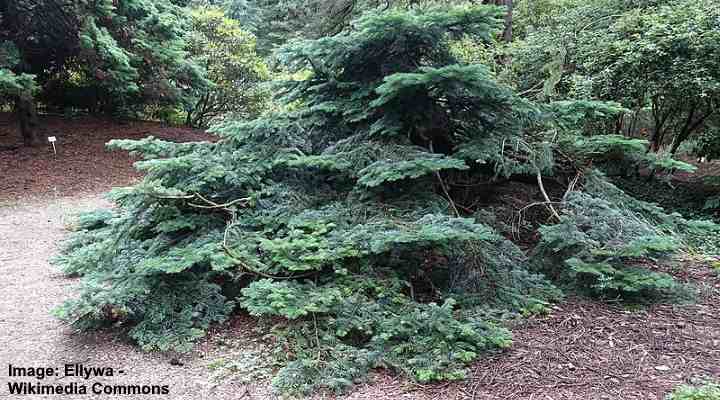
The ‘Spreading Star’ Pacific silver fir is an evergreen shrub with spreading growth habit that can be grown in both sun and shade
Pacific silver fir ‘Spreading Star’ is an evergreen dwarf conifer shrub that grows around 2 feet (0.6 m) tall in shaded landscapes. The coniferous shrub spreads across the ground. Its soft, thick foliage on arching branches create a natural carpet in partial or full shade. The slow-growing shrub grows 3” to 4” (7.5 – 10 cm) annually.
Pacific silver fir ‘Spreading Star’ is an excellent shrub for small, compact gardens. The shrub is perfect as ground cover, foundation planting, or to add texture to evergreen shrub borders.
USDA growing zones: 6 to 8
Sun exposure: Full sun to dense shade
Soil type: Moist, well-drained soils
Chinese Fringe Flower (Loropetalum chinense)
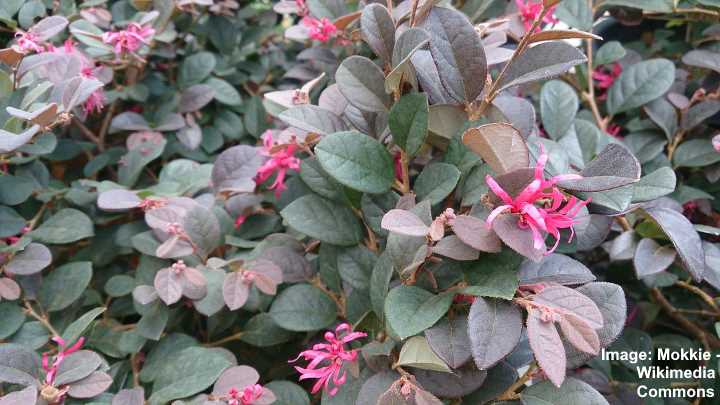
The compact Chinese fringe flower shrub has colorful foliage and deep pink or white flowers and can be grown in sunny or partial shaded gardens
The Chinese fringe flower is a shade-tolerant, evergreen shrub with showy white or pink spring-blooming flowers. Ornamental features of the shrub are its spidery flowers with slender, twisted petals and emerald-green leaves that persist all year on the mounding shrubby plant. Chinese fringe flower shrubs grow 1 to 6 ft. (0.3 – 1.8 m) tall and wide, depending on the cultivar.
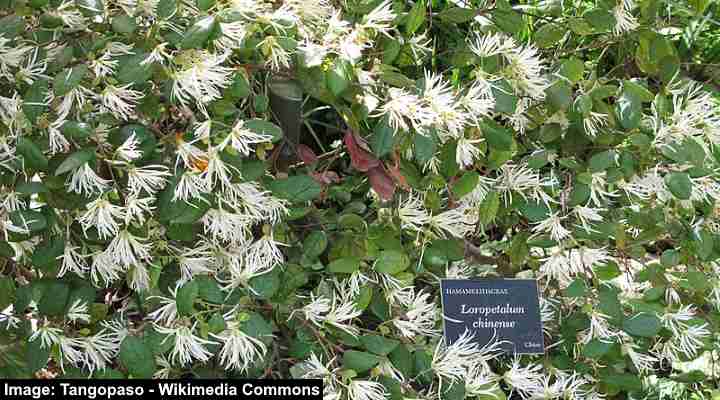
White flowering Chinese fringe flower (Loropetalum chinense ‘Emerald Snow’)
The evergreen shrubs are perfect for planting as a hedge, border, or specimen plant in a sunny or shady landscape.
USDA growing zones: 7 to 10
Sun exposure: Full sun to partial shade
Soil type: Fertile, humus-rich, well-drained soils
Anglo-Japanese Yew (Taxus × Media ‘Densiformis’)
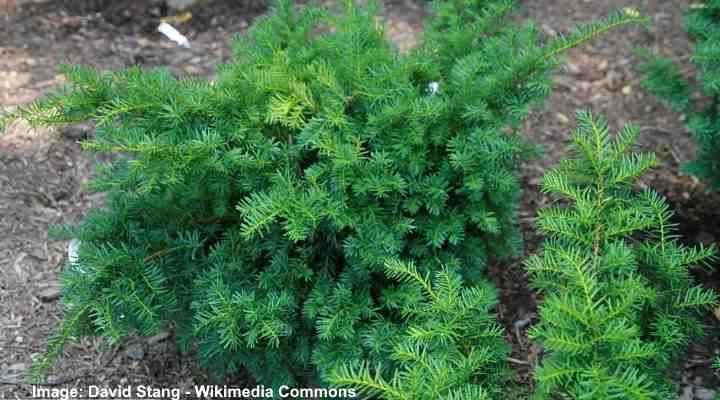
The spreading low growth habit of Taxus x media Densiformis makes it suitable as an evergreen ground cover plant for sun or shade
The semi-dwarf evergreen Anglo-Japanese yew shrub ‘Densiformis’ is a shade-loving bushy plant. It is an excellent landscaping plant for formal shaded gardens due to its compact, dense habit. The evergreen shrub features bright, glossy green needles, coral-red seed-bearing cones, and slow growth. It grows 3 to 4 ft. (0.9 – 1.2 m) high.
The ‘Densiformis’ Anglo-Japanese yew is ideal for planting as a low-growing evergreen hedge, specimen plant, or foundation planting. The shrub thrives just as well in full sun as in deep shade.
USDA growing zones: 4 to 7
Sun exposure: Full sun, partial sun, full shade
Soil type: Well-drained soils with average moisture
Cape Jasmine (Gardenia jasminoides)

The white flowers of cape jasmine bush add beauty and fragrance to partially shaded landscapes
Cape jasmine is a group of white-flowering shrubs that thrives in dappled light or partial shade. The stunning features of the ornamental shrubs are its fragrant, white, double-petaled flowers, dark green, lance-shaped leaves, and small orange or yellow oval fruits. The spectacular brilliant white flowers bloom in early summer and rebloom later in the season.
Cape jasmine shrubs grow 2 to 8 ft. (0.6 – 2.4 m) tall, depending on the variety. The evergreen plants are ideal for planting in foundation beds, mixed borders, and as specimen plants. Additionally, the fragrant blooms make excellent cut flowers for dried floral arrangements.
Cape jasmine shrubs thrive with morning sun and afternoon shade. However, they can withstand full sun exposure in cooler areas of their growing zones.
USDA growing zones: 7 to 10
Sun exposure: Full sun or partial shade
Soil type: Consistently moist, organically rich soils with excellent drainage
Russian Cypress (Microbiota decussata)
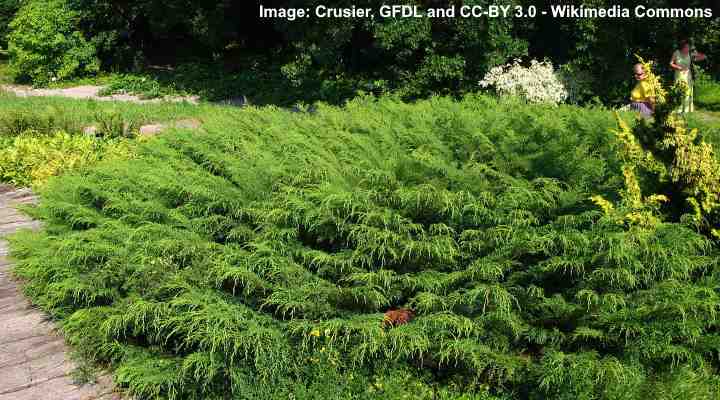
Russian cypress is a low growing evergreen shrub which is hardy in cold winters and tolerates partial shade
Russian cypress is a shade-tolerant evergreen shrub that doesn’t grow more than 2 feet tall. The coniferous shrub features feathery, scale-like bright green leaves. In the fall, its evergreen foliage turns an attractive bronze to purple color. The shrub is more shade-tolerant than other evergreen ground cover coniferous shrubs.
Russian cypress grows up to 2 ft. (0.6 m) tall and spreads 3 to 12 ft. (1 – 3.6 m) wide. Thanks to its low growth and spreading nature, it’s an excellent choice for evergreen ground cover in the shade, rock gardens, and borders. Russian cypress is also suitable for planting in containers or covering retaining walls where its soft, scaly foliage will spill over the sides.
USDA growing zones: 3 to 7
Sun exposure: Full sun or partial shade
Soil type: Moist, well-drained soils
Mountain Laurel (Kalmia Latifolia)
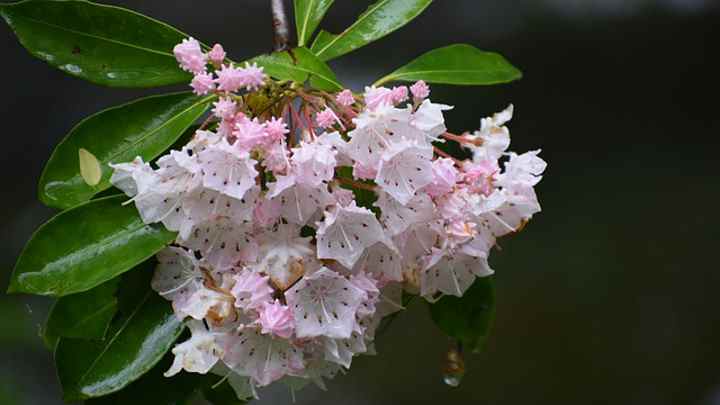
Mountain laurel is a flowering evergreen shrub that can tolerate some shade in the garden
Mountain laurel is a stunning evergreen shrub that thrives in partial shade. The ornamental plant produces clusters of pinkish-white cup-shaped flowers. The attractive, showy flowers have bright rose-pink spots and cover the shrub when blooming in late spring and early summer. The shrub’s glossy, dark green leaves provide year-round interest.
Mountain laurel grows 5 to 15 ft. (1.5 – 4.5 m) tall and wide. The slow-growing shrub is ideal for planting in partially shaded areas as a specimen plant, shrub border, or cottage gardens.
- USDA growing zones: 4 to 9
- Sun exposure: Partial shade
- Soil type: Moist, acidic, humus-rich, well-drained
Sweet Box (Sarcococca confusa)

A sweet box shrub and a close up picture of its flowers
Sweet box is a small evergreen shrub that blooms in winter with ivory-white fragrant flowers. This shade-loving shrub has glossy dark green leaves throughout the year. When blooming in late winter, the small, white, wiry flowers contrast with the shrub’s lush foliage. The flowers give way to shiny red berries that mature to black.
Sweet box grows 3 to 5 ft. (0.9 – 1.5 m) tall and wide. It is known for its clusters of delicate flowers that fill the air with a sweet, spicy fragrance. This low-maintenance, small, bushy plant grows well in partial to full shade. It’s a good landscaping option for planting in beds, borders, or a low-growing evergreen hedge.
Thanks to their tolerance to shade, sweet box shrubs are a great choice for planting under trees or in shaded areas of the garden. It’s also rabbit and deer-resistant and requires little maintenance to bloom year after year.
- USDA growing zones: 7 to 9
- Sun exposure: Full shade or partial shade
- Soil type: Humus-rich, moderately fertile, well-drained soils
Glossy-Leaved Paper Plant (Fatsia japonica)
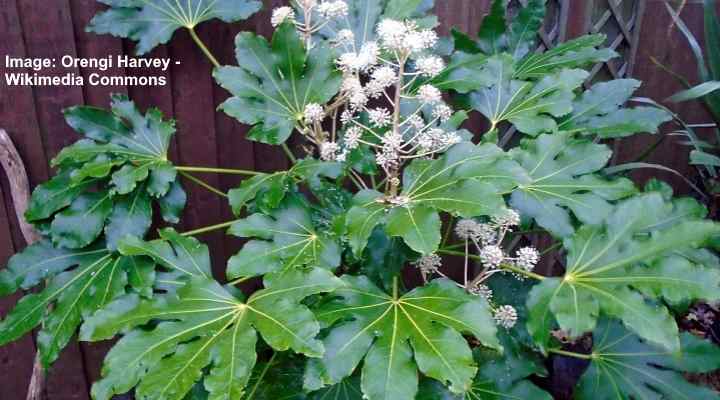
Glossy-leaved paper plant leaves and flowers
Glossy-leaved paper plant is a striking evergreen shrub with clusters of creamy-white flowers blooming in late fall. Ideal for shade planting, the small to medium-sized shrub is noted for its large, glossy, palmate leaves, delicate flowers in blooming umbels, and black berries in late fall or early winter.
Glossy-leaved paper plant grows 6 to 16 ft. (1.8 – 5 m) tall and wide. Its tropical, palmately lobed leaves are 16” (40 cm) wide, creating a bold and dramatic presence in landscapes. The shrub thrives in partial to full shade, making it ideal for gardens that receive less sunlight.
It tolerates drought, clay, and sandy soils, making it a relatively low-maintenance, shade-loving shrub. The shrub is useful as an accent plant, a hedge, or for growing in containers. Its fragrant flowers attract birds and butterflies to the garden.
- USDA growing zones: 8 to 10
- Sun exposure: Partial shade to full shade
- Soil type: Humus-rich, moderately fertile, well-drained soils
Japanese Plum Yew (Cephalotaxus harringtonia)
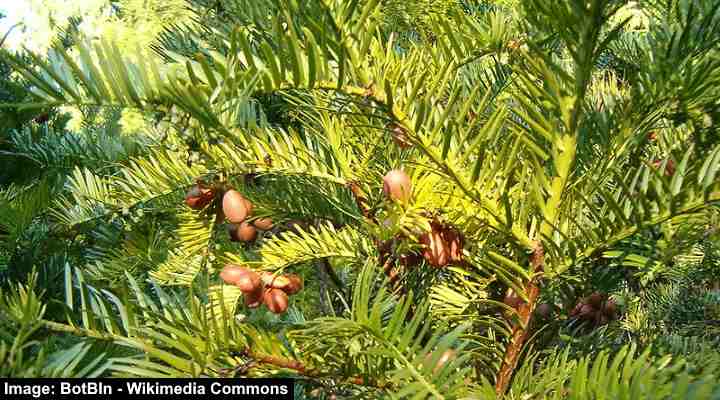
Japanese plum yew foliage and fruit
Japanese plum yew is a small evergreen shrub with needle leaves and a broad appearance. The shrub’s attractive appearance comes from its dense, spreading branches and dark green, needle-like foliage. The evergreen shrub produces small olive-like brown fruits called arils.
Japanese plum yew grows 5 to 10 ft. (1.5 – 3 m) tall and up to 14 ft. (4.2 m) wide. This slow-growing shrub is well-suited for landscaping shade gardens and woodland areas. It thrives in part to full shade and is tolerant of a wide range of soil types, including clay and sandy soils.
Landscaping ideas for the Japanese plum yew include as a specimen plant, a hedge, or as part of a mixed border. The unique texture and color of its foliage make it a standout feature in any garden.
- USDA growing zones: 6 to 9
- Sun exposure: Full sun, partial shade, deep shade
- Soil type: Well-drained clay to sandy soils, can tolerate some drought
Evergreen Azalea Shrubs (Rhododendron spp.)
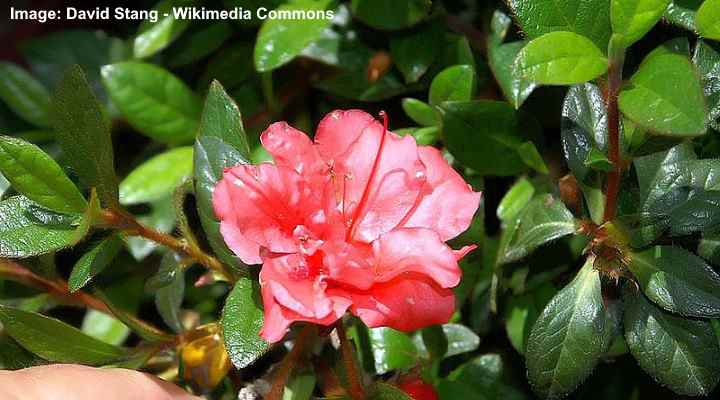
Encore azalea ‘Autumn Princess’
Evergreen azalea shrubs are known for their vibrant, papery, trumpet-shaped flowers. The showy flower clusters bloom in spring in a variety of colors, including pink, purple, red, and white. These spectacular, fragrant blooms contrast nicely with the small shrub’s glossy green foliage.
Evergreen azalea shrubs are from the Encore series. They thrive in partial shade and typically grow 2 to 3 feet tall (0.6 – 0.9 m), making them ideal for small gardens. The shrub’s evergreen foliage and showy spring flowers give it year-round interest even when not blooming.
Here are a few small evergreen azalea shrubs suitable for part shade:
Azalea ‘Autumn Chiffon’: This small flowering evergreen bush has pale pink flowers with darker pink speckles. It grows up to 3 ft. (0.9 m) tall and wide and tolerates filtered shade or dappled sunlight.
Azalea ‘Autumn Ruby’: This re-blooming shrub has scarlet-red funnel-shaped flowers 1.25” (3 cm) across. The small evergreen shrub grows up to 3 ft. (0.9 m) tall and wide and thrives in part shade.
Azalea ‘Autumn Ivory’: This small, white-flowering shrub has stunning, brilliant white flowers contrasting with its evergreen foliage. The small shrub tolerates cold and sun and blooms in spring and then late summer through fall. This azalea grows 2 to 3 feet (0.6 – 0.9 m) tall and wide.
Small evergreen azalea shrubs are ideal for partially shaded shrub borders, small hedges, container plants, or accent plants. Deadheading the shrubs after flowering in spring encourages repeat blooming from mid-summer until the first frost.
- USDA growing zones: 6 to 10
- Sun exposure: Full sun, dappled sunlight, or partial shade
- Soil type: Well-drained, humus-rich acidic soils
Daphne tangutica
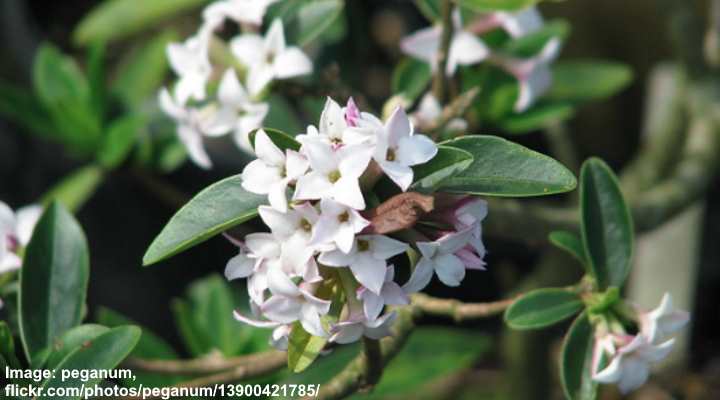
Daphne tangutica leaves and flowers
Daphne tangutica is an easy-to-grow, shade-tolerant evergreen shrub with purple-pink flowers outside and white and pale pink inside. This daphne variety has leathery, dark green leaves contrasting with clusters of small, fragrant, pink, purple, lavender, and white flowers in spring and summer. The flowers are followed by bright red berries that add a pop of color to fall landscapes.
Daphne tangutica grows 2 to 3 feet (0.6 – 0.9 m) tall and wide. It’s a slow-growing shrub with a compact, rounded shape, ideal for shade planting in small gardens. You can plant this daphne variety in full sun or partial shade as an accent plant, flowering shrub to attract pollinators, or in containers.
- USDA growing zones: 5 to 9
- Sun exposure: Full sun to partial shade
- Soil type: Well-drained, fertile soil
Gold-Edged Winter Daphne (Daphne odora ‘Aureomarginata’)
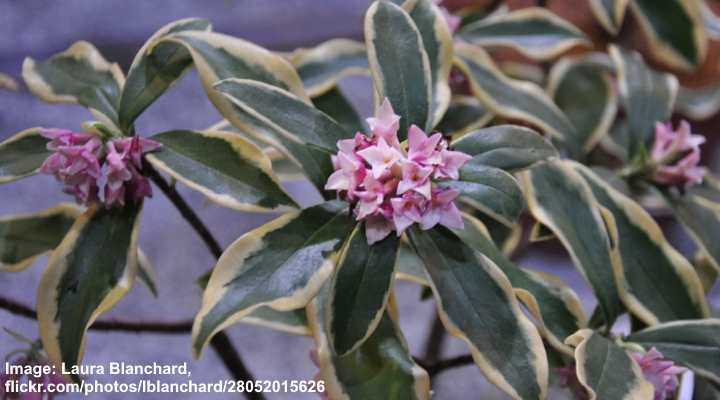
Winter daphne variegated leaves and flowers
Winter Daphne is a beautiful evergreen shrub with variegated leaves and fragrant pink flowers. Not growing taller than 4 ft. (1.2 m), this shrubby ornamental plant keeps its lush green color throughout the year. The attractive green leaves have creamy gold margins, and the shrub’s pink flowers have a sweet fragrance.
Winter Daphne grows 3 to 4 ft. (0.9 – 1.2 m) tall and wide. It is a slow-growing shrub that prefers dappled shade and well-drained soil. You can plant winter Daphne in foundation plantings, borders, or as a specimen shrub. It also looks spectacular as an evergreen flowering hedge.
- USDA growing zones: 7 to 9
- Sun exposure: Partial shade
- Soil type: Well-drained, fertile soil in a sheltered position
Daphne Eternal Fragrance (Daphne × transatlantica ‘Blafra’)
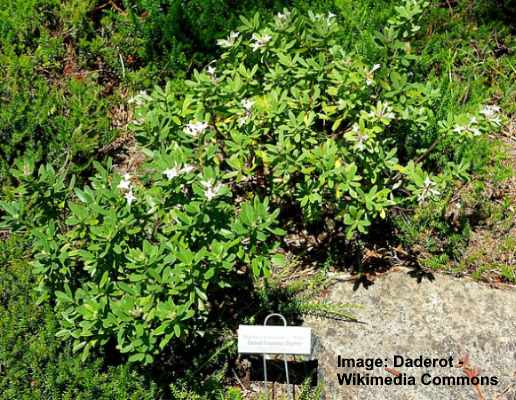
A Daphne ‘Eternal Fragrance’ shrub
Daphne ‘Eternal Fragrance’ is a compact shrub that blooms from spring to fall. Identifying features of this small shrub are its highly fragrant white flowers and dark green elliptic leaves. The four-petalled white flowers are trumpet-shaped and bloom in small clusters. In colder regions, the shrub is semi-evergreen.
Daphne ‘Eternal Fragrance’ grows 2 to 3 feet (0.6 – 0.9 m) tall and wide. It has a mounding habit and glossy, dark green leaves. Thriving in partial shade, the white-flowering shrub is ideal for shade gardens in borders, foundation plantings, or near patios to enjoy its fragrant flowers.
You can also plant Daphne ‘Eternal Fragrance’ in containers to attract butterflies and bees.
- USDA growing zones: 5 to 9
- Sun exposure: Partial shade
- Soil type: Well-drained, fertile soils that are consistently moist
Banana Shrub (Magnolia figo)
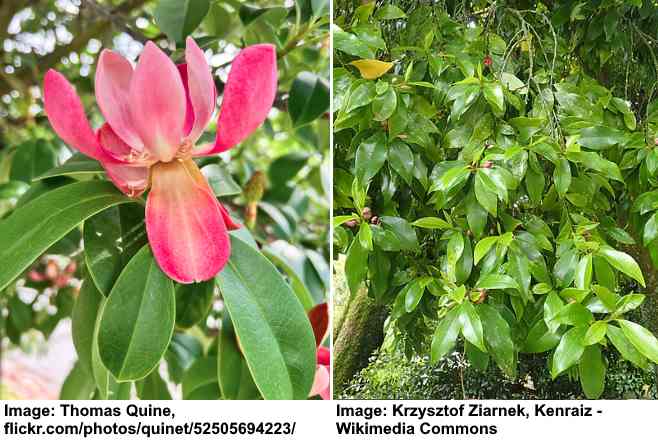
Banana magnolia is a multi-stemmed shrub with creamy-yellow or purple-pink flowers, depending on the cultivar
The banana shrub is a type of ornamental magnolia plant with fragrant creamy-yellow or pink flowers. It’s an evergreen shrubby plant with magnolia-like glossy green leaves with brown undersides. The flowers are cup-shaped and smell like ripe bananas. The yellowish or pink flowers bloom in late spring to early summer, attracting bees and butterflies to the garden.
The banana shrub grows 6 to 15 ft. (1.8 – 4.5 m) tall and up to 8 ft. (2.4 m) wide. Its tolerance to salt spray makes it ideal for landscaping beachfront properties or other coastal areas. You can also plant banana shrubs in shade borders, foundation plantings, or as specimen plants.
This shade-loving shrub is low-maintenance and drought-tolerant once established.
- USDA growing zones: 7 to 10
- Sun exposure: Full sun or partial shade
- Soil type: Well-drained, slightly acidic loamy or sandy soil
Anise (Illicium parviflorum)
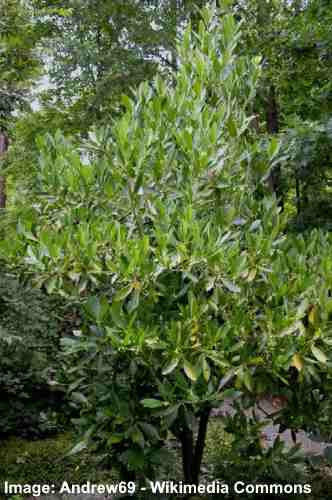
Anise (Illicium parviflorum)
Anise is an aromatic evergreen shrub prized for its aromatic foliage and unique star-shaped flowers with strap-like petals. This shade-loving plant has shimmering, green leaves that emit a strong licorice scent when crushed. Blooming from spring through early summer, the shrub produces small, maroon-colored flowers with yellow centers that resemble stars.
Small evergreen anise shrubs grow 3 to 4 ft. (0.9 – 1.2 m) tall and wide. The attractive, ornamental shrub thrives in part to full shade. Its low maintenance and adaptability make it well-suited for shade borders, foundation planting, low-growing screens, or garden dividers.
The shrub is also deer-resistant and attracts butterflies and hummingbirds.
- USDA growing zones: 7 to 9
- Sun exposure: Partial shade to full shade
- Soil type: Moist, well-drained soils with organic matter
Dwarf Burford Holly (Ilex cornuta ‘Dwarf Burford’)
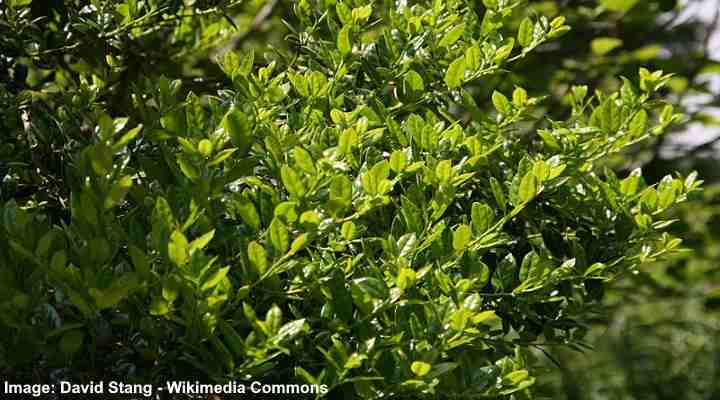
Dwarf Burford Holly (Ilex cornuta ‘Dwarf Burford’)
Dwarf Burford holly is a compact evergreen shrub with clusters of white flowers, glossy dark green leaves, and vibrant red berries. This small decorative shrub has a dense, rounded form and performs well in partially shaded gardens. The white-flowering shrub blooms in spring and retains its lush foliage throughout the year.
Dwarf Burford holly grows 6 to 8 ft. (1.8 – 2.4 m) tall and wide. After blooming, the white flowers give way to bright red berries that add a splash of color to fall and winter landscapes. Dwarf Burford holly is also deer-resistant and requires little maintenance to stay healthy and vibrant.
The versatile plant is ideal for coastal or inland garden landscapes. In a small yard, you can plant it as an accent, border, hedge, or privacy screen. It also works well in foundation planting for evergreen foliage.
- USDA growing zones: 7 to 9
- Sun exposure: Full sun to partial shade
- Soil type: Well-drained, fertile soil, high in organic matter
Heavenly Bamboo ‘Flirt’ (Nandina domestica ‘Murasaki’)
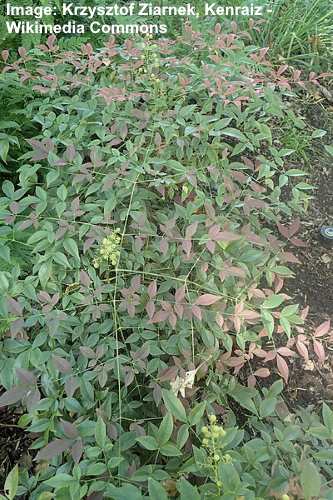
Heavenly Bamboo ‘Flirt’ (Nandina domestica ‘Murasaki’)
Heavenly bamboo ‘Flirt’ is a small evergreen shrub that grows under 2 feet (0.6 m) tall in partial shade. This dwarf shrub is known for its erect, upright canes, bamboo-like leaves, whitish flowers, and red berries. Heavenly bamboo ‘Flirt’ blooms in late spring, and its vibrant berries persist from fall through winter.
Heavenly bamboo ‘Flirt’ grows 2 to 3 ft. (0.6 – 0.9 m) tall and wide. Its compact growth makes it perfect for small gardens or as a border plant, foundation planting, or informal hedge. It thrives in part shade and is adaptable to various soil types. This low-maintenance shrub is also deer-resistant and drought-tolerant once established.
- USDA growing zones: 6 to 9
- Sun exposure: Part shade to full shade
- Soil type: Well-drained soil, adaptable to various soil types with medium moisture
Hicks Yew (Taxus canadensis)
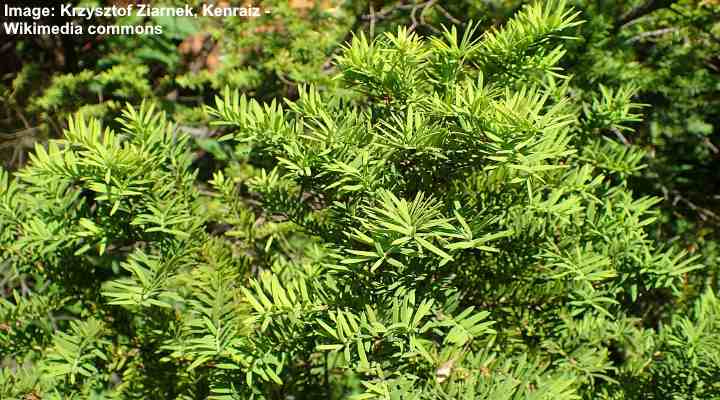
Hicks yew doesn’t require much care and is a shade-loving adaptable shrub
Hicks yew is a small, dense evergreen shrub that thrives in partial to heavy shade. It’s a slow-growing shrub with a spreading habit. Its aromatic branches have narrow, flat, dark green needle leaves, providing year-round interest. In summer, red berry-like cones appear, adding spots of color to the landscape.
Also called the American yew, this native dwarf shrub grows 3 to 5 ft. (0.9 – 1.5 m) tall and up to 8 ft. (2.4 m) wide. It is a versatile, slow-growing, shade-tolerant shrub that performs well in moist, well-drained soils.
Landscaping uses for this sprawling evergreen shrub include planting near ponds or streams, using in mixed borders, or as a specimen plant. Additionally, the evergreen shrub is deer-resistant and can tolerate a range of soil types.
- USDA growing zones: 3 to 7
- Sun exposure: Partial sun to heavy shade
- Soil type: Well-drained soil, adaptable to different soil types
English Yew (Taxus baccata ‘David’)
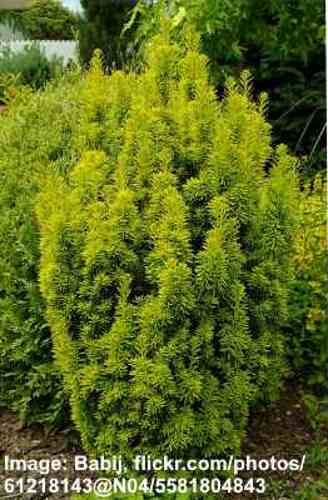
Taxus baccata ‘David’
English yew is an evergreen shrub with narrow green, gold-edged leaves. This coniferous shrub is known for its dense, columnar growth habit, bright green foliage, and coral-red seed-bearing cones. Ideal for compact gardens, the small, narrow shrub adds vertical accents in heavily shaded landscapes.
English yew ‘David’ grows 8 to 10 ft. (2.4 – 3 m) tall and only 2 ft. (0.6 m) wide. This popular landscaping shrub is ideal for creating formal hedges, lining a property foundation, or growing as a specimen plant. Its evergreen foliage provides year-long interest in gardens.
As with all yew plants, this variety is highly toxic. Therefore, planting it away from areas where children or pets play is best.
- USDA growing zones: 7 and 8
- Sun exposure: Full sun, part shade, or deep shade
- Soil type: Well-drained, evenly moist soils
Florida Hobblebush (Agarista populifolia)
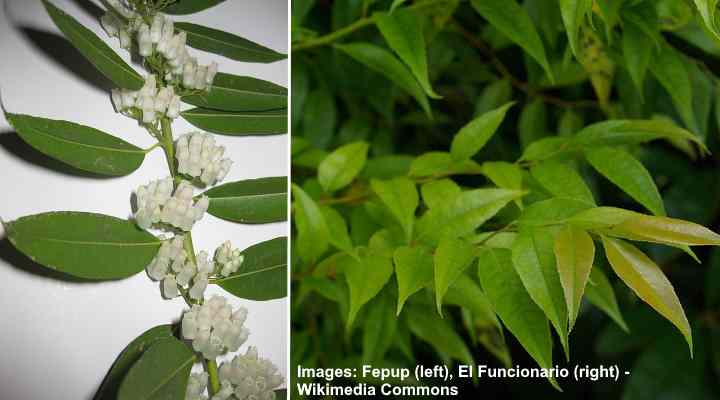
Florida hobblebush flowers and leaves
Florida hobblebush is a shade-loving evergreen shrub that blooms in spring and summer with creamy-white, fragrant flowers. Native to the southeastern United States, this small to medium-sized shrub features glossy, dark green leaves and clusters of white, bell-shaped flowers and orange-brown seed pods. These appear on arching branches, giving the shrub an ornamental appeal.
Florida hobblebush grows 8 to 12 ft. (2.4 – 3.6 m) tall and 6 ft. (1.8 m) wide. It’s a decorative shrub, ideal for heavily shaded gardens. Hobblebush has vigorous growth and keeps its foliage throughout the year in warmer climates. Also, its tolerance for damp, soggy soil makes it ideal for planting near water features like ponds or streams.
Also called tall fetterbush, this evergreen shrub is perfect for landscaping shade gardens. It works well in groupings to create an informal hedge or screen. Additionally, you can plant it in borders or use its evergreen foliage to create a privacy hedge. Its attractive foliage and flowers make it a beautiful addition to any shade garden.
- USDA growing zones: 7 to 9
- Sun exposure: Full shade to partial shade
- Soil type: Well-drained, acidic, fertile soils that are consistently moist
Evergreen Clematis (Clematis ‘Pixie’)
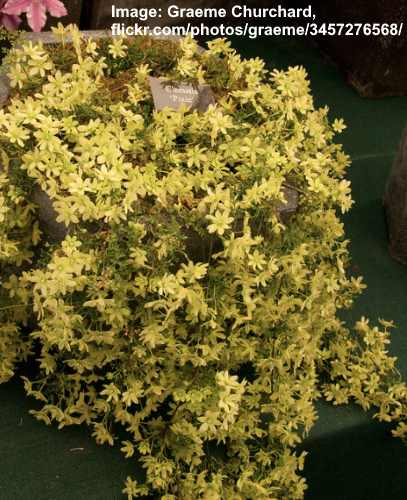
Evergreen Clematis (Clematis ‘Pixie’)
Evergreen clematis is an attractive trailing evergreen shrub that blooms in late spring in partially shaded conditions. The compact spreading shrub produces abundant lime-yellow flowers for several weeks. Its foliage consists of finely divided green leaves growing on thin, trailing, purplish stems.
Evergreen clematis grows 3 to 4 ft. (0.9 – 1.2 m) tall and wide. Its trailing, spreading nature makes it great for ground cover in gardens with partial shade. Additionally, the climbing plant is useful for creating stunning vertical displays. You can train it to climb trellises, fences, or walls, creating a stunning vertical display.
- USDA growing zones: 4 to 9
- Sun exposure: Partial shade to full shade
- Soil type: Well-drained, fertile soil
Japanese Spurge (Pachysandra terminalis)
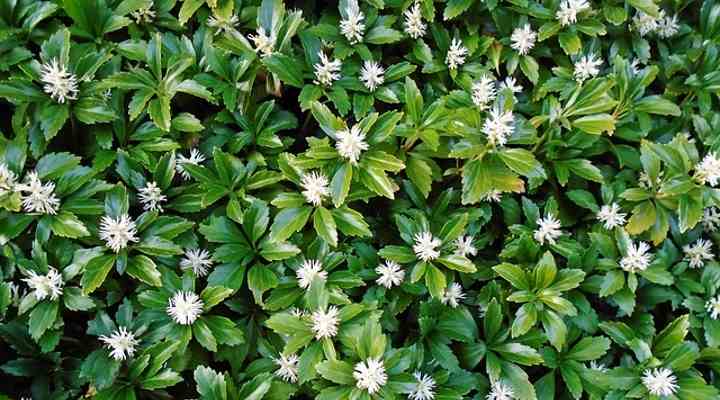
Japanese spurge foliage and flowers
Japanese spurge is a low-growing evergreen groundcover plant with shrubby growth. This spreading plant creates a mat of lush, dark green foliage in shaded landscapes. It also blooms every spring with small spikes of white flowers, adding to its ornamental value. The shade-loving evergreen plant doesn’t grow taller than a foot (0.3 m).
Japanese spurge spreads rapidly through underground rhizomes. It usually grows 3” to 4” (7.5 – 10 cm) tall and spreads up to 8” (20 cm) wide. Thanks to the thick carpet of foliage, it’s excellent for covering shaded areas where grass struggles to grow. It’s also a useful landscaping option for underplanting shrubs or soil erosion control.
Japanese spurge is also deer and rabbit-resistant, making it a popular choice for gardeners. The small evergreen shrub is also tolerant of urban pollution and clay soils.
- USDA growing zones: 4 to 8
- Sun exposure: Partial shade to full shade
- Soil type: Well-drained, medium moisture soils
Coastal Doghobble (Leucothoe axillaris)
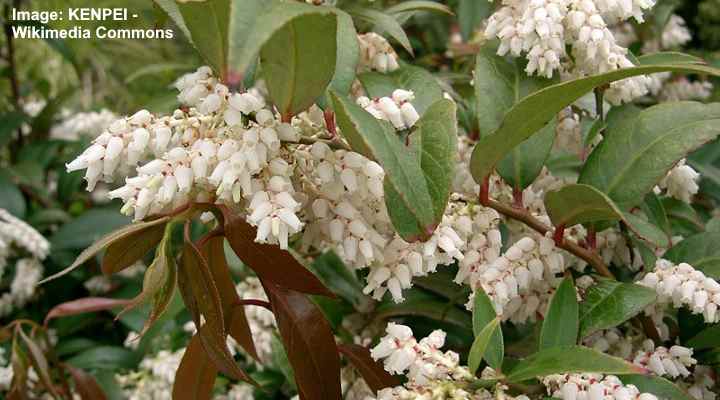
Coastal doghobble has attractive white flowers and is small enough to decorate shaded gardens with a limited space
Coastal doghobble is a versatile evergreen, shade-tolerant shrub that grows around 2 feet (0.6 m) tall. The shrubby plant has a spreading vase shape with spikes of white, heather-like flowers and leathery dark green leaves. In the fall, the foliage turns from dark green to bronze. Its bloom time is spring.
Coastal doghobble grows 2 to 4 ft. (0.6 – 1.2 m) tall and spreads up to 5 ft. (1.5 m) wide. Its abundant bell-shaped white flowers fill the air with sweet spring and early summer fragrances. It’s excellent for ground cover, borders, foundation planting, or underplanting larger shrubs.
As its name suggests, coastal doghobble has excellent tolerance for salt spray. Therefore, it’s a good evergreen green shrub for growing in coastal conditions and gardens near the ocean.
This low-maintenance shrub is also deer-resistant and requires little pruning. It is adaptable to various soil types, including sandy and clay soils. Coastal doghobble is an attractive and durable option for shade gardens in coastal regions.
- USDA growing zones: 6 to 9
- Sun exposure: Partial shade
- Soil type: Well-drained, fertile soil
Doghobble Shrub (Leucothoe fontanesiana)
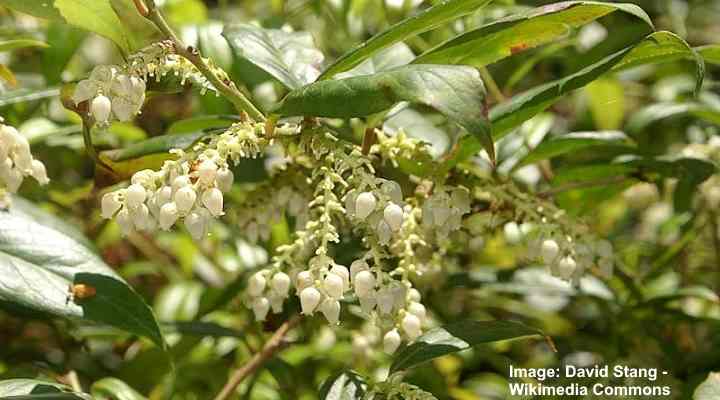
The shade tolerant dog hobble evergreen shrub has delicate white flower clusters and is quite small
Doghobble shrub is known for its masses of creamy-white, urn-shaped flowers dangling in large clusters. This small evergreen shrub thrives in dappled sunlight and deep shade. Its ornamental features are its leathery, dark green glossy leaves that turn bronze or purple in winter, flowering clusters 3” (7.5 cm) long, and arching branches.
Doghobble shrub typically grows 3 to 6 ft. (0.9 – 1.8 m) tall and wide. Its compact growth and weeping nature make it suitable for planting in shade gardens as a deer-resistant border plant or foundation planting. The dense foliage remains on the shrub throughout winter, helping keep landscapes lush and colorful.
- USDA growing zones: 5 to 8
- Sun exposure: Partial shade to deep shade
- Soil type: Moist, well-drained, acidic soil
California Christmas Berry (Heteromeles arbutifolia)
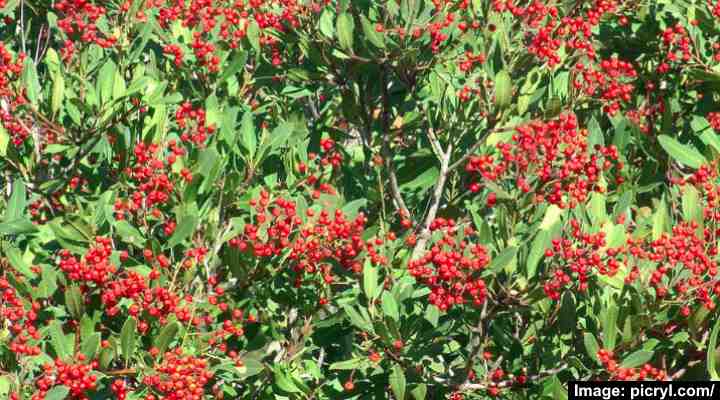
California Christmas berry foliage and fruit
California Christmas berry has stunning white flowers, attractive foliage, and vibrant red berries. The shade-tolerant evergreen shrub blooms profusely in summer with flat-topped flower clusters. These are followed by pea-sized shiny red berries contrasting with the sharply-toothed, dark green leaves. The white flowers have a fragrance resembling hawthorn.
Evergreen California Christmas berry shrubs grow 6 to 8 ft. (1.8 – 2.4 m) tall and 5 ft. (1.5 m) wide. This drought-tolerant shrub tolerates partial shade and is adaptable to a variety of soil types. The ornamental shrub performs well in warm climates as a hedge, screen, or foundation planting.
In addition to its ornamental value, California Christmas berry is also a valuable plant for attracting pollinators, such as bees and butterflies. It’s a low-maintenance shrub that requires little pruning or care once established.
- USDA growing zones: 9 to 11
- Sun exposure: Full sun to partial shade
- Soil type: Well-drained soils and tolerant of poor, dry, sandy, and clay soils
Silk Tassel Bush (Garrya elliptica)
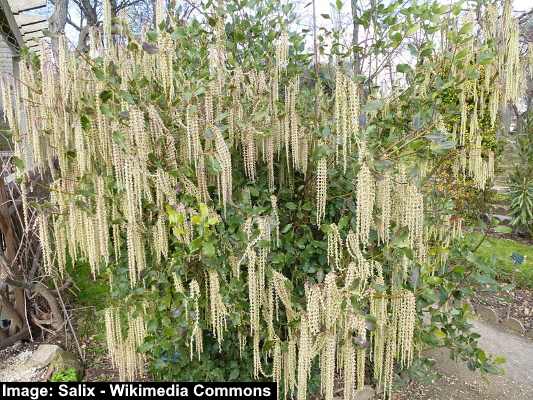
A silk tassel bush with dangling catkins
Silk tassel bush is a striking evergreen shrub with eye-catching long, drooping, silver-gray catkins. The creamy white dangling flower clusters can measure 8” (20 cm) long. The small to medium-sized shrub has leathery, oval leaves. In summer, the bushy plant produces bunches of round berries in grape-like clusters.
The silky flowering tassels are the evergreen shrub’s most identifiable features. It grows from 6 to 15 ft. (1.8 – 4.5 m) tall and up to 10 ft. (3 m) wide. Ideal for planting in partial shade, the shrub grows well along a foundation line or in mixed shrub borders, hedgerows, or containers.
Silk tassel bush is drought-tolerant once established and a great choice for gardens with dry or rocky soil. In hot, dry climates, afternoon shade is essential to protect its thick foliage.
- USDA growing zones: 8 to 11
- Sun exposure: Full sun to partial shade
- Soil type: Well-drained, sandy, or rocky soils
Wintergreen (Gaultheria procumbens)
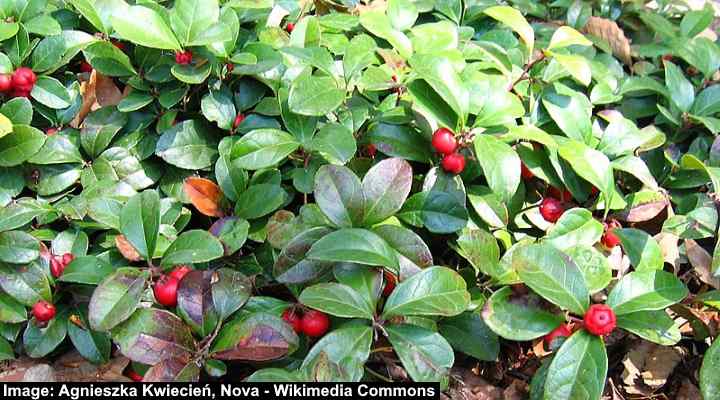
Wintergreen leaves and fruit
Wintergreen is a low-growing evergreen shrub prized for its pink flowers, lustrous, leathery leaves, and bright scarlet berries. This full shade-loving shrub doesn’t grow over 2 feet (0.6 m) tall. Its characteristic features are its spreading nature, prostrate stems, evergreen foliage, and nodding pinkish or white bell-shaped flowers.
Wintergreen is native to North America and is commonly found in woodland areas. The dwarf shrub typically grows 3” to 6” (7.5 – 15 cm) tall and spreads indefinitely. It has small, oval-shaped leaves that release a pleasant wintergreen fragrance when crushed. In late summer, the shrub produces small, white or pinkish flowers that give way to vibrant red berries in fall.
Landscaping uses for wintergreen include ground cover in shaded garden areas, understory planting, or beds and borders. Its spreading growth and robust root system are ideal for erosion control on banks or near streams and ponds. In addition to its ornamental value, wintergreen attracts birds, bees, and butterflies.
- USDA growing zones: 3 to 9
- Sun exposure: Partial sun to full shade
- Soil type: Organically rich, moist, well-drained, acidic soil
Mock Orange (Pittosporum tobira ‘Nanum’)
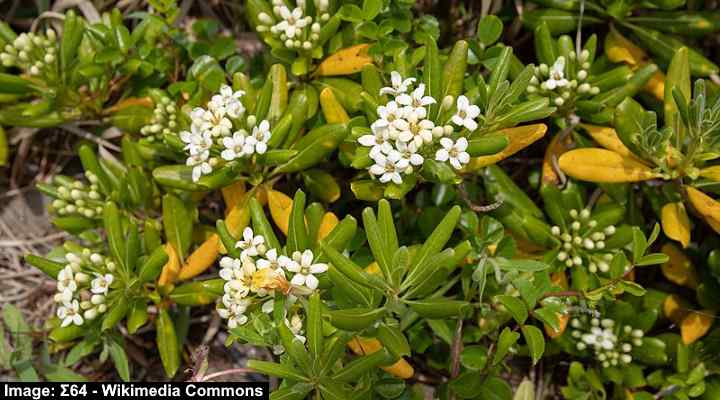
Mock orange foliage and flowers
The mock orange cultivar ‘Nanum’ is a compact evergreen shrub that doesn’t grow taller than 2 feet (0.6 m). It has small, five-petalled fragrant flowers and thick, leathery, oblong leaves growing in whorls along its stems. Its blooms emit a sweet, citrus-like fragrance in late spring or early summer.
Mock orange is a versatile plant with several landscaping uses. The small, fragrant shrub performs well as a low hedge, border plant, or in containers. Its dense foliage and compact size make it an ideal choice for small gardens or for planting in shaded areas. Its salt air tolerance means it grows well in coastal landscapes.
This shade-tolerant mock orange shrub is relatively low-maintenance, only requiring occasional pruning to maintain its shape. It is also deer-resistant, and its fragrant flowers attract butterflies to the garden.
- USDA growing zones: 8 to 12
- Sun exposure: Full sun to partial shade
- Soil type: Well-drained, moderately fertile soil
Fetterbush (Lyonia lucida)
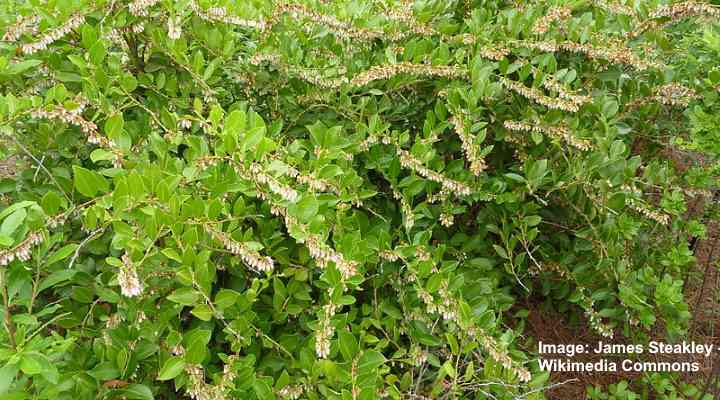
Fetterbush (Lyonia lucida)
Fetterbush is an evergreen shrub that thrives in partially shaded areas. Native to the southeastern United States, the small shrub blooms in spring with clusters of small, bell-shaped pink or white flowers. The shrub features arching, sprawling stems with oval to elliptic leaves 2” to 4” (5 – 10 cm) long.
Fetterbush grows 3 to 6 feet (0.9 – 1.8 m) tall and wide. Its pinkish flowers fill garden landscapes with beautiful pastel colors in early to late spring. Its tolerance to poorly drained, boggy soils makes it ideal for planting small gardens with poor drainage. It also performs well in the shade as an informal hedge, shrub border, or foundation planting.
Fetterbush shrubs are also a good choice for rain gardens or along streams and ponds. Additionally, its flowers attract butterflies and other pollinators to shade gardens.
- USDA growing zones: 7 to 10
- Sun exposure: Full sun to partial shade
- Soil type: Acidic, well-drained acidic soils, and will tolerate occasional flooding
Hebe ‘Silver Queen’ (Hebe elliptica ‘Variegata’)

Hebe ‘Silver Queen’ (Hebe elliptica ‘Variegata’)
Hebe ‘Silver Queen’ is a small evergreen shrub that brightens partially shaded gardens. The shrub’s outstanding ornamental features are its green and creamy-white variegated leaves, spikes of purple flowers, and bushy, spreading nature. The stunning multi-colored foliage and attractive flowers create a striking contrast in spring, summer, and fall gardens.
Hebe ‘Silver Queen’ grows 2 to 3 ft. (0.6 – 0.9 m) tall and wide. Thriving in full sun, dappled sunlight, or partial shade, the mounding plant is ideal for small gardens in warm climates. You can plant it in containers, shaded borders, pathway edges, or mixed beds. Hebe ‘Silver Queen’ also works well as a low-growing dividing hedge in formal garden landscapes.
- USDA growing zones: 9 and 10
- Sun exposure: Full sun to partial shade
- Soil type: Moist, well-drained soils, protected from summer heat and winter cold
Growing Small Evergreen Shrubs in the Shade
Small evergreen shrubs are ideal for adding a splash of color to a shady garden. Many shade-tolerant shrubs add color from spring through fall when in bloom. Then, their evergreen foliage keeps your front or backyard looking lush and healthy throughout winter. However, choosing and caring for small evergreen shrubs in the shade can be challenging.
How to Pick the Right Evergreen Shrubs for Shade
Factors to consider when choosing evergreen shrubs for shaded areas are their mature size, shade conditions, and purpose. Here are a few tips on picking the right shade-loving evergreen shrubs:
Assess light and shade levels: Understand the specific shade conditions in your front or backyard. Also, pay attention to areas beside fencing, walls, or your property that may be in constant shade. Some evergreen shrubs prefer shade from the afternoon sun. However, other shrubs perform well in two or three hours of direct sunlight daily.
Consider the shrub’s mature size: Small evergreen shrubs are generally more suitable for compact shaded spaces. Avoid selecting plants that will outgrow the available space. Remember, some coniferous shrubs take ten or 20 years to reach their mature size.
Choosing the planting area: Apart from sunlight levels, you must consider soil type, drainage, and USDA hardiness zone. Most small evergreen shrubs require well-drained soil. However, you must check the soil’s pH levels to select the right shrub for the planting area.
How to Prune Evergreen Shrubs
Choosing small evergreen shrubs for shade typically eliminates the need for pruning. However, in some cases, pruning can help maintain the shrub’s height and shape and encourage more blooming. Additionally, the lack of sunlight can cause some small shrubs to become leggy in the shade.
Here are a few tips on pruning different types of small evergreen shrubs:
Know your shrubs: Research the specific needs and growth habits of the evergreen shrubs in your yard. Different species may have different pruning requirements.
Timing: Prune evergreen shrubs when dormant, typically in late winter or early spring. It’s best to avoid pruning during the late summer or fall because this can stimulate new growth that may die before winter.
Know what to remove: Start by cutting damaged, diseased, or dead branches to promote plant health. Next, thin out branches to increase air circulation and light penetration. Cut off any leggy branches that spoil the shrub’s overall shape and appearance.
Cut at an angle: Make angled cuts just above a set of healthy leaves, buds, or nodes. This encourages outward growth and prevents water from settling on the cut surface.
Avoid over-pruning: Small evergreen shrubs generally require less pruning than larger ones. Don’t over-prune the shrub, as it can stress the plant and lead to sparse foliage. Generally, never prune more than one-third of the shrub’s growth.
How to Care for Evergreen Shrubs Growing in the Shade
Evergreen shade-tolerant shrubs are generally easy to care for in a garden landscape. But there are a few important aspects to remember for shrubs to thrive in the shade. For example, they may require less watering because they don’t get direct sunlight. Also, established shrubs don’t need as much moisture as newly planted ones.
Here are some tips on caring for evergreen shrubs in shade gardens:
- Ensure the soil is well-draining and rich in organic matter.
- Water shrubs when the top layer of soil is dry.
- Watering frequency depends on air temperature, humidity, soil drainage, and sunlight exposure.
- Provide adequate mulch around the shrubs to retain moisture and suppress weed growth.
- Inspect shrubs regularly for common diseases and pests. Then, prune and treat as needed.
Fertilizing Evergreen Shrubs in Shade Gardens
It’s best to wait until evergreen shrubs are well-established before fertilizing. But some established shrubs may not need fertilizer if they grow in high-quality, organically rich soil. If you think shrubs require fertilizing, it’s best to use a slow-release fertilizer and follow the instructions carefully.
Most gardeners test soil nutrient levels before applying fertilizer. This way, you can determine the correct NPK levels to boost your shrub’s health.
Related articles:
